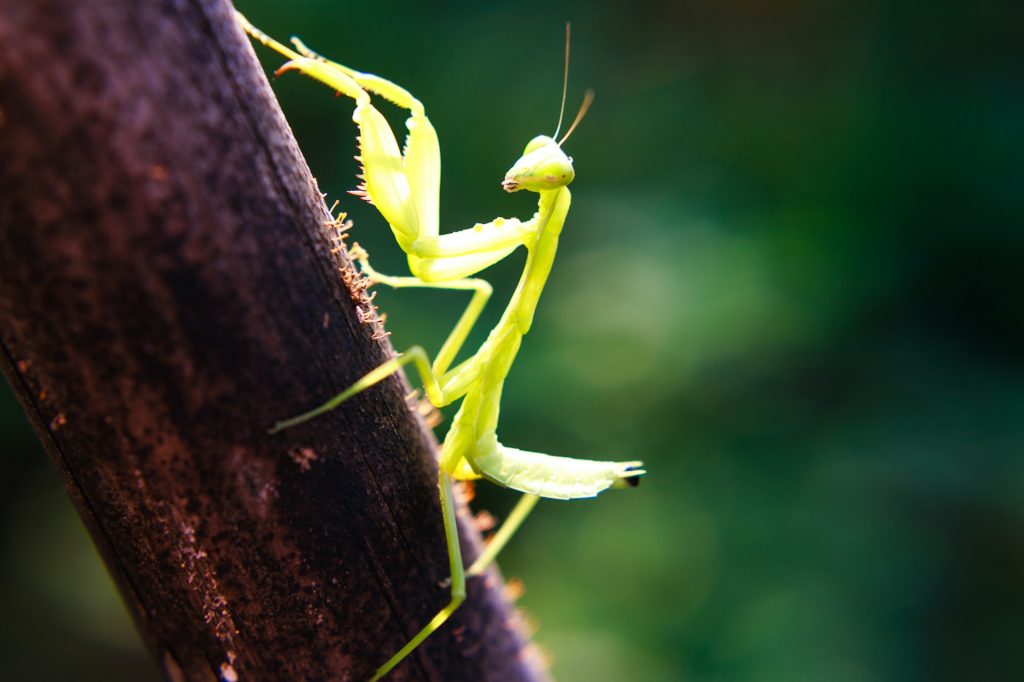Are praying mantis nocturnal? A praying mantis cannot simply be defined as nocturnal but are rather more flexible and adapt to a variety of opportunities whether day or night. They are active during both daytime and night-time to catch their prey when the opportunity arises.
Praying mantis’ are closely related to the grasshopper and is scientifically named an orthopterous insect that is part of the Mantidae or Mantodea family. They can be found on every continent on earth apart from Antarctica. There are over two-thousand known species of praying mantis in the world. Some of the most well-known praying mantis species include:
- Mantis Religiosa (European praying mantis)
- Tenodera Sinensis (Chinese praying mantis)
- Stagomantis Carolina (Carolina praying mantis)
- Hiedordula tenuidentata (Giant Asian mantis)
Are praying mantis nocturnal or diurnal?
A nocturnal animal is one that is active during night-time and asleep during the day, while a diurnal animal is active during the day time and sleeps during night time.
A praying mantis is a solitary predator that can be defined as both diurnal and nocturnal. They feed at night as well as during the day, whenever the opportunity arises, on live insects such as moths, mosquitoes, roaches, aphids, and flies.
What does a praying mantis do at night? At night, praying mantis try to satiate their large appetite by feeding on moths, they are the only predator known to do so. However, praying mantis are active during both the daytime and night-time, whenever their prey is readily available. They feed on moths and other nocturnal insects at night, and diurnal or daytime insects and small mammals in the day.
They are predatory insects and usually remain in one place until their prey comes toward them. Mantis can detect the slightest movements of their prey and can see the movement as far as sixty feet away.
Can praying mantis see in the dark?
A praying mantis has a unique pigment in its eyes which gathers during darkness or low lighting conditions. After a mantis is in darkness for about half an hour, the dark pigment is visible in its eyes. In light, the pigment will gradually disappear and the eyes will once again appear light-colored.
Do praying mantis sleep at night?
Little research has been carried out on sleep in praying mantis. However, something comparable to human sleep has been noted in various insects including mantis. During sleep, a mantis is defended through their natural camouflage and cannot be seen while they sleep. Mantis sleep when their prey isn’t available. They are more at risk when flying than when sleeping due to their camouflage.
Nocturnal animals sleep during the day time and are only active at night. Praying mantis can be active during both the day and night, and sleep when their prey isn’t available, unlike nocturnal creatures who are only active during the night. Despite that a praying mantis can be active during the day and night, it will usually hide during the night.
Do praying mantis hunt at night?
Mantis are usually active when their prey is active and easy to catch. Their diet includes a large variety of insects, bugs, and pests. A praying mantis eats a large variety of insects and bugs such as grasshoppers, flies, cockroaches, stink bugs, leafhoppers, caterpillars, aphids, beetles, moths, and crickets. They do not merely feed on other insects but also small birds, spiders, and mammals such as hummingbirds.
They are known as carnivores and mostly eat other insects or bugs. However, they often also supplement their diet with pollen, especially when their preferred prey is not available.
They are predators that are known to ambush and wait for their prey. When they are about to catch their prey, they wait with their front legs raised. In some instances, praying mantis do feed on each other.
They have special hearing organs that are located at the bottom of their legs, this often helps common mantises to detect bat calls during the night and prevent them from being eaten.
At night-time, bats often feed on insects that they find through echo locations. Bats send off a high-pitched sound and listen to the echo that bounces off any insect in its area. When a praying mantis hears the loud sound, it knows that the bat is nearby. To avoid being attacked or eaten by the bat, it will suddenly move and let itself fall to the floor. It is likely that the bat was not prepared for this and will miss the mantis.
Do praying mantis fly at night?
Some male species of mantis will fly to look for females at night. However, during the flight, a praying mantis is not protected by its normal camouflage but has developed preventative techniques to avoid bats and many can detect the location of bats through echo.
Tip: Click here to learn how praying mantis do fly.
References
- https://plantcaretoday.com/praying-mantis.html#are-mantises-nocturnal
- https://www.sanbi.org/animal-of-the-week/african-mantis/#:~:text=The%20praying%20mantises%20are%20solitary%20diurnal%20or%20nocturnal%20ambush%20predators.&text=Praying%20mantises%20have%20unique%20hearing,and%20hence%20avoid%20being%20eaten.

